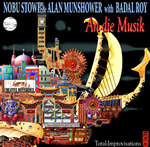Home » Jazz Articles » Album Review » Nobu Stowe: An die Musik
Nobu Stowe: An die Musik
Stowe interacts with his instrument ceaselessly implementing his cognizance of its capacity to tell stories, no matter how abstract, no matter how intertwined with tunefulness, no matter how energized and interconnected with his percussion partners.
The infusion of the dry, quick, metallic tonality of the tabla throws a sense of grounded-ness into the group's wanderlust, beginning with "Trio I." It pulls the instruments into a heartbeat and a present moment that somehow eludes the piano and the drum set. This is not to say that Stowe and Alan Munshower do not do the job of constructing endlessly elegant sonorous jaunts; rather that the choice to include Badal Roy's sensitive touch on the tabla, whether to lead the trio into its groove (Trio II), play solo (Solo Tabla) or deeply complement the piano (Trio III, Trio VI), is brilliant. Providing any other type of rhythm aside from what is expected, endows the music with newness, breadth and universality.
Each cut seems to explore new tempo territory. There is a stark difference between "Trio I," in which Stowe travels gracefully and steadily up and down the keyboard and the succeeding "Duo V." In the latter, Stowe stays on this side of producing a full-blown boogie-woogie as Munshower chases the pianist to keep up, more abstractly than rhythmically.
The fast/slow juxtapositions from one improvisation to the next lend a classical structure to the entire album, where each part can be understood as a movement, as opposed to simply another track. This design brings integrity to the music and transcends any potential for an iPod-type of isolation that favors and lifts one part completely out of context.
Stowe has exceptional strength. He can make quick and beautiful transitions from combinations of bass chord structures to right-handed tune phrasing (Trio III, Trio VI). He draws them out and shapes them into powerful interlocking repeated statements whose destination becomes thoroughly evident when thematic material is broached again, twisted around, stretched even more and unfurled without question until the last note.
Munshower demonstrates his responsiveness to the piano as he extends its insistence through smoothly rat- a-tatting and occasionally snapping at the snare, rolling out a brushed sibilance on the cymbal or supplying percussive sounds (Duo VII, Trio VI). He lets loose only once, in "Trio VI."
From start to finish, this music is vivid. And portends that someday, there will be more.
Track Listing
Duo I; Trio I; Duo V; Trio II; Duo IV; Trio III; Duo VII; Solo Tabla; Duo III; Trio IV; Pochi.
Personnel
Nobu Stowe
pianoNobu Stowe: piano; Alan Munshower: drums; Badal Roy: tabla.
Album information
Title: An die Musik | Year Released: 2008 | Record Label: Soul Note
< Previous
Ron McClure: Wonderland, Always & Bet...
Comments
Tags
For the Love of Jazz
 All About Jazz has been a pillar of jazz since 1995, championing it as an art form and, more importantly, supporting the musicians who create it. Our enduring commitment has made "AAJ" one of the most culturally important websites of its kind, read by hundreds of thousands of fans, musicians and industry figures every month.
All About Jazz has been a pillar of jazz since 1995, championing it as an art form and, more importantly, supporting the musicians who create it. Our enduring commitment has made "AAJ" one of the most culturally important websites of its kind, read by hundreds of thousands of fans, musicians and industry figures every month.




















